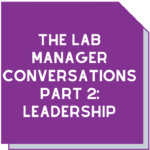The Lab Manager Conversations part four – Communication
We’ve been speaking to lab managers and leaders about their roles and challenges. These conversations have been collated into a series of articles that will probably resonate not only with lab leaders, but those across other businesses as well.
While their pathways may have been somewhat different, all our respondents have clocked up well over 10 years of experience prior to their current roles. They also cover the spectrum of calibration, chemical, microbiology, electrical, inspection and environmental laboratories.
And although they were pleased to talk through their issues, by request we’ve changed their names to maintain confidentiality.
Communication
Clearly communication is a skill all managers require. In fact, we’ve written about this before. It’s critical to have clear lines of communication across all aspects of the lab.
 “Little grass roots issues could lead to bigger problems if you don’t get on top of them quickly,” says Chris. And this isn’t just about interpersonal communication.
“Little grass roots issues could lead to bigger problems if you don’t get on top of them quickly,” says Chris. And this isn’t just about interpersonal communication.
“We had a change in a process for a test we did infrequently. Since this is something we only do maybe once a quarter, nobody would remember or immediately recognise that there was a change. So, we had to work out how to capture that information in a way that’s logical and achievable for everyone affected. Deciding things as a team gives everyone a chance to be heard.”
Lab processes and procedures are critical parts of your systems. In fact, they are probably the most critical because it is the output of these processes and procedures which delivers something to the customer. But giving team members the opportunity to have their say is more likely to ensure buy in.
While regular meetings with both individuals and teams seemed to be the preferred method of communicating, this isn’t always an option.
Matthew: “In a small lab, you’re all so busy. We just don’t have time to sit down and have regular meetings because we’re just flat out. I think having good, simple systems in place is even more important in a small lab. When something changes or something happens, you know exactly where to find that information.”
Remember, having a meeting is not a requirement of any standard – effective communication is!
Wise use of time
Between management activities, testing, paperwork and liaison with customers and colleagues, everyone mentioned that time was their most precious commodity. Therefore, finding the best and most efficient way of communicating with staff was key.
Lisa: “I have regular catch ups with my team members, so they know they’ll have the opportunity to raise anything with me then. I just expect them to carry on with their work and not approach me with other issues unless it’s urgent.”
 Labs are sometimes part of a larger organisation which means that there will also be communication from other areas. Sometimes information from management can be confusing and it’s up to the lab manager to distil this.
Labs are sometimes part of a larger organisation which means that there will also be communication from other areas. Sometimes information from management can be confusing and it’s up to the lab manager to distil this.
“If there are changes being proposed or implemented by management, this can lead to some anxiety among staff,” explains Daniel. “It’s my job to put these changes into context and perhaps explain the background to the decision. That’s why developing trust in the relationship is so important. They’re relying on me for information and reassurance plus they have the opportunity to express their concerns in a safe place. It also means I gain valuable feedback to take back to management.”
The key takeaways in terms of communication with staff was making sure it was timely and appropriate. Nobody wants to sit in meetings that could have been an email!
But for complex matters, choose the best method or mix of methods that work for your people. This could be a combination of a face-to-face meeting followed by an email summary of the discussion and any points raised.
Managing conflict
Like any other workplace, labs are a petri dish of personalities, needs, desires and ambition. And as a manager, it’s your job to ensure this mix doesn’t become volatile. All of our respondents agreed that this was their least favourite part of the role.
 Lauren had an issue with a staff member speaking disrespectfully to someone else in a meeting.
Lauren had an issue with a staff member speaking disrespectfully to someone else in a meeting.
“You can’t let this go,” she said. “I was also aware of other comments that this person had made so I knew it wasn’t an isolated incident. Getting this sorted right away is important. It sets the tone for the rest of the team and shows them what is acceptable and what isn’t”.
Lisa uses staff surveys to obtain feedback. “If a few people raise a particular issue around an individual, this can be a starting point for a discussion. This method means you’re feeding information back to a staff member from other team members rather than an individual,” she explains. “People are more likely to give feedback this way, particularly if the issue is sensitive. Sometimes a staff member doesn’t want to come forward because they worry about being singled out”.
Naturally, everyone had their own approach in how they managed conflict but there was agreement that there shouldn’t be a delay in handling issues. In Daniel’s words: “Difficult conversations mean you do have to be sensitive but don’t drag it out. Sometimes you just need to rip off the band aid.”
Finding agreement isn’t always possible
Everyone agreed that despite all good intentions and intervention, sometimes there’s only one solution.
 Chris: “If there’s a deep-rooted dislike of another colleague, you’re never going to break through that. You can’t change personalities. The key is to catch it early and then hear them out in front of each other. Remind them it’s a workplace and if you can’t find a solution, someone must go. Having that conversation with them in the same room, face-to-face, means that they know you’re taking this seriously. And that’s particularly the case if this issue is impacting the business.”
Chris: “If there’s a deep-rooted dislike of another colleague, you’re never going to break through that. You can’t change personalities. The key is to catch it early and then hear them out in front of each other. Remind them it’s a workplace and if you can’t find a solution, someone must go. Having that conversation with them in the same room, face-to-face, means that they know you’re taking this seriously. And that’s particularly the case if this issue is impacting the business.”
Matthew agrees: “Conflict can mean that someone’s needs or expectations aren’t being met. And maybe that leads to them being disruptive. In a small lab, it doesn’t take long for that to start influencing morale and output. So you need to sit down and discuss that with them and talk about finding a way forward. But sometimes that just doesn’t happen, and you have to be realistic. Sometimes people just don’t fit it, won’t fit in, or can’t fit in.”
Victor agrees with trying to sort it out but “sometimes it just won’t work. If they can’t let go and keep being disruptive, you just need to make a change. If it’s impacting the business this is particularly important. Because as a manager, your responsibility is to the whole organisation.”
However, if it does turn out to be a bigger issue driving negative behaviour, managers may need support to determine the underlying issue. If an organisation has an HR Department, they can be called on to step in. But for a small business, an external organisation may need to be brought in. We’ve written previously about workplace friction how to deal with this.
What if it’s you?
Dealing with issues between staff members is one thing. But what happens if that conflict is between the lab manager and a staff member?
 Lauren: “If it’s a single incident, say they were confrontational during a meeting and it was part of robust discussion, I’d probably let it go. I mean, not everyone agrees with me all the time! But you can always get a sense if it’s something more or part of an ongoing issue. If that were the case, I’d cut it off during the meeting and tell them we’ll discuss this offline. Then I’d talk to them afterwards and ask what’s going on – is there something they’re struggling with? Is there something I’m missing?”
Lauren: “If it’s a single incident, say they were confrontational during a meeting and it was part of robust discussion, I’d probably let it go. I mean, not everyone agrees with me all the time! But you can always get a sense if it’s something more or part of an ongoing issue. If that were the case, I’d cut it off during the meeting and tell them we’ll discuss this offline. Then I’d talk to them afterwards and ask what’s going on – is there something they’re struggling with? Is there something I’m missing?”
Brian says that it may not be you. “They could have something not related to work and they’re just venting. And look, we’ve all had issues at home that spill over. I understand that work isn’t the only thing in their lives so I can overlook some things. But if this is affecting how they work, then we need to talk about making a change, even if it’s just for a little while so they can get themselves sorted.”
Overall though, he’s very happy with how he and his team deal with conflict. “Maybe once a year something will flare up but we get on top of it quickly and get it sorted,” he says. “Plus, we’re a small team and we’re so busy, we don’t have time to be mad at each other!”
Next week – how do managers handle their own learning?
Download the article The Lab Manager Conversations series part four – Communication




